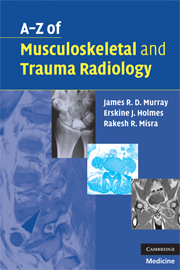Book contents
- Frontmatter
- Contents
- Acknowledgements
- Preface
- List of abbreviations
- Section I Musculoskeletal radiology
- Achilles tendonopathy/rupture
- Aneurysmal bone cysts
- Ankylosing spondylitis
- Avascular necrosis – osteonecrosis
- Femoral-head osteonecrosis
- Kienböck's disease
- Back pain – including spondylolisthesis/spondylolysis
- Bone cysts
- Bone infarcts (medullary)
- Charcot joint (neuropathic joint)
- Complex regional-pain syndrome
- Crystal deposition disorders
- Developmental dysplasia of the hip (DDH)
- Discitis and vertebral osteomyelitis
- Disc prolapse – PID – ‘slipped discs’ and sciatica
- Diffuse idiopathic skeletal hyperostosis (DISH)
- Dysplasia – developmental disorders
- Enthesopathy
- Gout
- Haemophilia
- Hyperparathyroidism
- Hypertrophic pulmonary osteoarthropathy
- Irritable hip/transient synovitis
- Juvenile idiopathic arthritis
- Langerhans-cell histiocytosis
- Lymphoma of bone
- Metastases to bone
- Multiple myeloma
- Myositis ossificans
- Non-accidental injury
- Osteoarthrosis – osteoarthritis
- Osteochondroses
- Osteomyelitis (acute)
- Osteoporosis
- Paget's disease
- Perthes disease
- Pigmented villonodular synovitis (PVNS)
- Psoriatic arthropathy
- Renal osteodystrophy (including osteomalacia)
- Rheumatoid arthritis
- Rickets
- Rotator-cuff disease
- Scoliosis
- Scheuermann's disease
- Septic arthritis – native and prosthetic joints
- Sickle-cell anaemia
- Slipped upper femoral epiphysis (SUFE)
- Tendinopathy – tendonitis
- Tuberculosis
- Tumours of bone (benign and malignant)
- Section II Trauma radiology
Langerhans-cell histiocytosis
from Section I - Musculoskeletal radiology
Published online by Cambridge University Press: 22 August 2009
- Frontmatter
- Contents
- Acknowledgements
- Preface
- List of abbreviations
- Section I Musculoskeletal radiology
- Achilles tendonopathy/rupture
- Aneurysmal bone cysts
- Ankylosing spondylitis
- Avascular necrosis – osteonecrosis
- Femoral-head osteonecrosis
- Kienböck's disease
- Back pain – including spondylolisthesis/spondylolysis
- Bone cysts
- Bone infarcts (medullary)
- Charcot joint (neuropathic joint)
- Complex regional-pain syndrome
- Crystal deposition disorders
- Developmental dysplasia of the hip (DDH)
- Discitis and vertebral osteomyelitis
- Disc prolapse – PID – ‘slipped discs’ and sciatica
- Diffuse idiopathic skeletal hyperostosis (DISH)
- Dysplasia – developmental disorders
- Enthesopathy
- Gout
- Haemophilia
- Hyperparathyroidism
- Hypertrophic pulmonary osteoarthropathy
- Irritable hip/transient synovitis
- Juvenile idiopathic arthritis
- Langerhans-cell histiocytosis
- Lymphoma of bone
- Metastases to bone
- Multiple myeloma
- Myositis ossificans
- Non-accidental injury
- Osteoarthrosis – osteoarthritis
- Osteochondroses
- Osteomyelitis (acute)
- Osteoporosis
- Paget's disease
- Perthes disease
- Pigmented villonodular synovitis (PVNS)
- Psoriatic arthropathy
- Renal osteodystrophy (including osteomalacia)
- Rheumatoid arthritis
- Rickets
- Rotator-cuff disease
- Scoliosis
- Scheuermann's disease
- Septic arthritis – native and prosthetic joints
- Sickle-cell anaemia
- Slipped upper femoral epiphysis (SUFE)
- Tendinopathy – tendonitis
- Tuberculosis
- Tumours of bone (benign and malignant)
- Section II Trauma radiology
Summary
Characteristics
Poorly understood spectrum of conditions.
Characterised by proliferation of Langerhans cells (similar to mononuclear macrophages).
Can occur at any age; most present in childhood.
Sub-divided into eosinophilic granuloma (80%), Hand–Schüller–Christian disease (10%) and Letterer–Siwe disease (10%).
Clinical features
Eosinophilic granuloma – relatively benign. Often presents with non-specific bone pain in the 5–10 year age group.
Letterer–Siwe disease – acute disseminated form tends to present early in infancy with wasting, hepatosplenomegaly and lymphadenopathy. Pancytopenia common.
Hand–Schüller–Christian disease – chronic form. Presents in the 5–10-year-old group with diabetes insipidus, exopthalamos and lytic skull lesions.
Radiological features
Lesions are usually well defined with a lucent centre and serrated and bevelled edge. A sclerotic margin is seen in the healing phase. True expansion is rare.
Lesions common in skull and axial skeleton.
Skull lesions often appear ‘punched out’ and may coalesce to form a geographical pattern. Differential inner- and outer-table involvement may give the appearance of a hole within a hole.
Vertebrae plana – vertebral bodies appear flattened with a preserved disc height.
Long bones – usually diaphyseal, respecting the epiphyseal plate and joint. Again, lytic with a sclerotic rim.
Mandibular involvement can lead to the appearance of ‘floating teeth’.
Management
Orthopaedic management generally targete0d to obtaining a definitive tissue diagnosis.
If accessible, excision/curettage or radiotherapy should be considered.
Chemotherapy for aggressive forms.
- Type
- Chapter
- Information
- A-Z of Musculoskeletal and Trauma Radiology , pp. 78 - 80Publisher: Cambridge University PressPrint publication year: 2008



